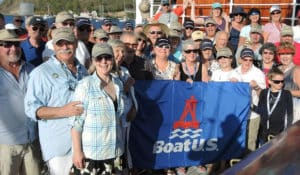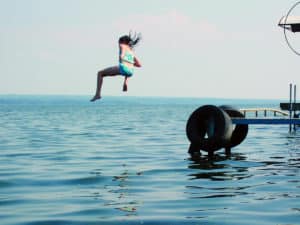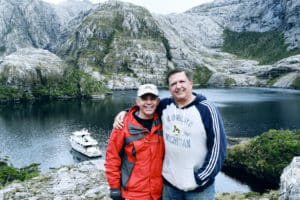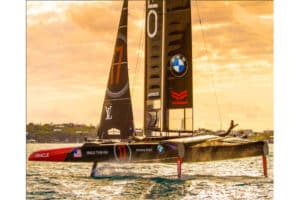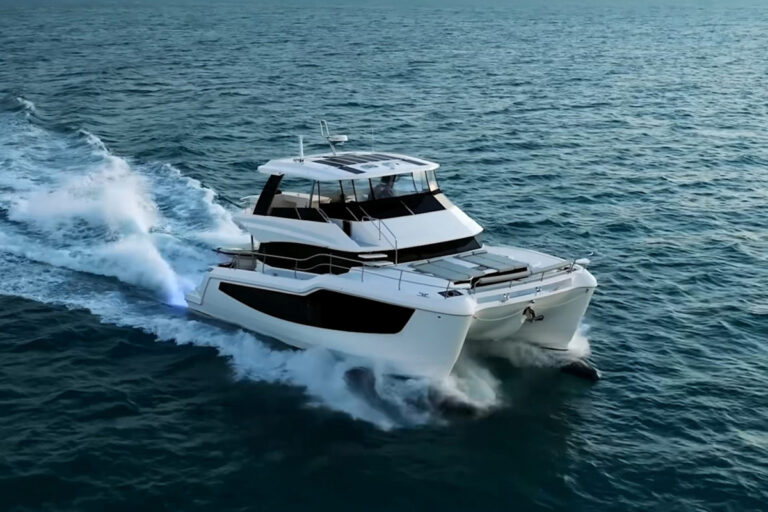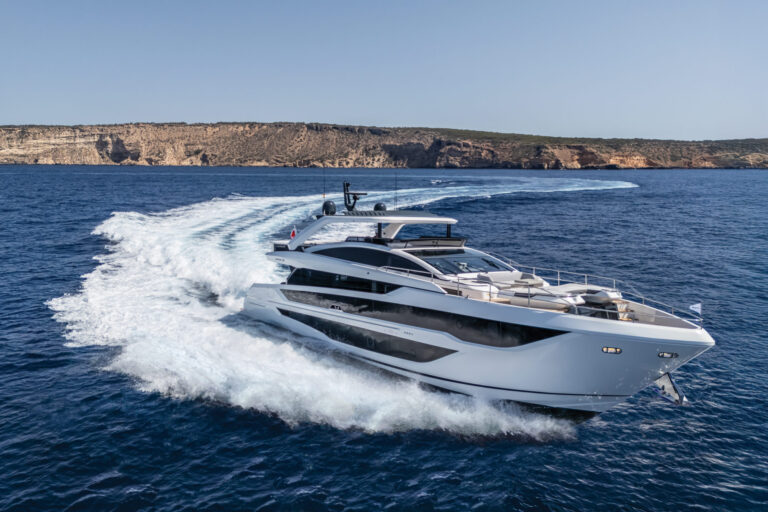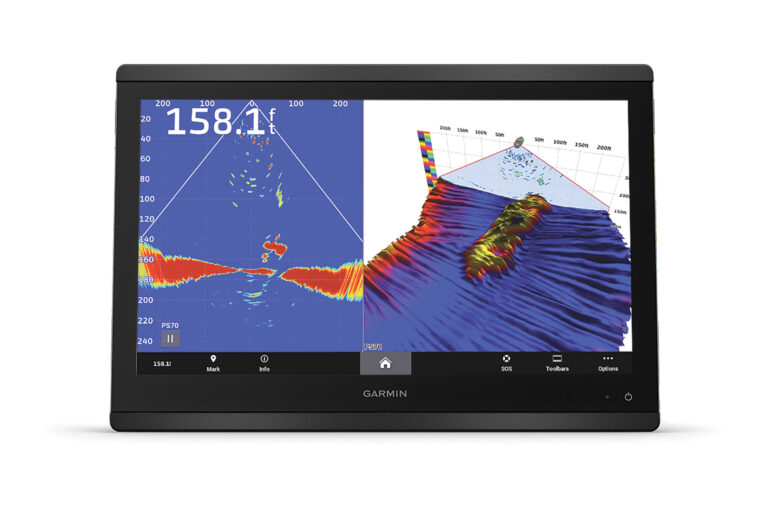“Can we do this by e-mail?” asks Philippe Kahn, his words streaming into my inbox from some undisclosed location: It could be from a beach, a boat, or a boardroom-I have no way of knowing. It is my second request for an interview in person. At first I get the sense that I am being blown off, albeit politely.
It is easy to understand why Philippe Kahn, named one of the 20 Most Important People in the history of the computer industry by BYTE magazine, might be pressed for time. When I first contact him he is getting ready to take delivery of his new TP 52 and race it in the TransPac. Two of his four children are on the one-design circuit, and like a good Little League dad, Kahn is making sure they have the best coaches, boats and crew money can buy. Kahn’s Team Pegasus is a syndicate of sorts that lists nearly 50 people, including a dozen Olympic medalists and contenders, and an armada of boats ranging from the Optimist pram his daughter Sophie sails to the 29er, 49er, Melges 24 and 18-foot skiffs that his 15-year-old son Samuel (a.k.a. “Shark”) campaigns, to the Finns, 505, Star, Farr 40 and now the TP 52 that Dad competes in.
When he’s home in Santa Cruz, Calif., Kahn spends time with his wife, Sonia Lee, a Silicon Valley graphics whiz kid herself, sailing for fun or working on their foundation, which donates to such causes as the U.S Olympic Sailing Team, the International Wolf Center and the Southern Poverty Law Center. Kahn also plays classical flute and is passionate about jazz. He has a triple black belt in karate that he earned when he was 20. He windsurfs, he surfs and he snowboards. He rides his dirt bike or mountain bike, he pilots his own plane.
Oh yes, and Philippe Kahn has a job-although at 52, the former math teacher, born to a mother who was a refugee from a Nazi concentration camp and an engineer father who had served in the French Foreign Legion, could easily retire. First, Kahn founded Borland Software and took it public. Then he and Sonia Lee started Starfish to develop wireless integration systems and sold that to Motorola in 1998 for $253 million. After that came Lightsurf Technologies, a pioneer in transmitting images via wireless. Last January, Verisign paid about $270 million in stock for Lightsurf. That buys a lot of 505s and Optimist prams, homes in Hawaii and snowboarding trips. But still Kahn has a job and a new project.
But no one, not even the best minds in the communications field, is quite sure exactly what Philippe Kahn is up to. And that may be one reason why he is insisting on doing this interview via e-mail.
“Our future is pervasive…” Kahn writes on fullpower.com, the home page of his latest company. “What pervasive communications means to each and every one of us is the ability to take our own worlds of personal and business information with us wherever we go.” The image on the home page is of Kahn sailing his Melges 24 off Santa Cruz. A link leads to an article from Outside magazine naming Santa Cruz, Silicon Valley’s nearest oceanfront real estate, one of the best towns to live in. The words that stream across the bottom of the home page are: “Fullpower is in stealth mode, focused on the convergence of Life Sciences and Wireless. We will launch publicly on February 15, 2007.”
On the Web site are links to other Kahn sites and bits and pieces of his personal and professional lives, tacked like pictures and quotes push-pinned to a virtual cubicle’s soft walls. I scan them, looking for hints about his next venture. One link leads to a picture of a rectangular box, with the headline “Computer related news from 1973!” The box is a Micral, one of the first personal computers based on a microprocessor. Philippe Kahn, a young French mathematician, barely out of the Swiss Polytechnic Institute, developed the software for it. A decade later, he went to Santa Cruz on a vacation, outstayed his tourist visa, and ended up founding Borland Software in 1982.
After creating such applications as Turbo Pascal, SideKick, dBase and Quattro Pro, Borland sold them at a fraction of what the competition was charging, marketing them aggressively and growing to be the third-largest software company in the world. In an industry where guerrilla tactics pay off, Kahn upstarted the upstarts. He once hosted a toga party at a trade show and showed up as Bacchus, a role his larger-than-life body (he was pushing 300 pounds at the time) and personality seemed perfect for. At Microsoft, one rival product team began wearing T-shirts that bore the slogan “Delete Philippe.”
Then the Borland board ousted Kahn. According to Kahn, it was because the board would not back his new commitment to wireless technology. Kahn went ahead and formed Starfish, and then once he sold that, launched Lightsurf. The new company’s big breakthrough came about as Kahn and Lee were expecting their daughter Sophie. Kahn sat in the delivery room with his cell phone, his laptop and his digital camera, struggling until he could make all three work together so the couple could send out live images of the baby girl. Eureka: The cell phone camera was born. “I predict that by 2002 the unit sales of Wearable Connected Information Devices will surpass the sales of personal computers,” Kahn said in an address at Stanford in 1998. He was right. And camera phones were just the first stage of that vision.
Resigned to communicating by e-mail and text messaging, I lob over my first question and hit send: “Who is more proficient at text messaging and sending visuals, you or your daughter?” This elicits an instant reply and a “” from him: “We are both pretty good,” he writes. “After all, she was born with it.” A day before the start of the TransPac, Kahn is somewhere in Los Angeles and he has already posted pictures of his brand-new TP 52 Pegasus (all of his boats are named Pegasus). Also on the Pegasus racing site are links to his past racing logs.
In the 2003 log there is a picture that Sophie, at the time age 6, sent of herself by Sprint PCS picture phone to her father, who at the time was about a day’s sail off Diamond Head. In another posting, dated September 21, 2004, Kahn remarks on a video mail Sophie sent him: “It made my day to hear her play the first measures of Debussy’s ‘Children’s Corner.’ I was so proud I shared it with everyone in my business meetings.”
Kahn’s son Shark has raced the past two TransPacs with him, in 2001 at age 10 becoming the youngest competitor ever. Shark learned to sail at the Kahn’s home in Oahu on an outrigger canoe. Since then, he has rotated in and out of a variety of high-performance one-designs, training with the best crews and the best coaches in each class. Recently, he’s been leaving a stream of professional sailors in his wake. At age 14 Shark won the Melges 24 Worlds. Now 15, he is on the U.S. Sailing Team.
In many ways, Philippe and his son learned to race side by side, each sailing with his own all-star team, to the point where they are equally competitive. At the 2004 Mumm 30 Worlds in Toronto last year, Philippe was leading the regatta when Shark, in fourth place, fouled his father. Philippe threw up the protest flag. (“It was one of the hardest things I’ve ever done,” Philippe said after the race.) Shark accepted the penalty, did his circles, and-a true sportsman-said his father did the right thing.
Kahn did not grow up sailing. He had learned to windsurf in France when he was 14 and got into sailboat racing when he moved to the Bay Area. In 1988 he did his first Pacific crossing in a chartered boat named Kathmandu, setting a San Francisco-Oahu record that stood for 10 years. In 2001, he won the biennial TransPac Barn Door trophy, and in 2002 was first to finish in the Farallon Singlehanded race. For a while, Kahn followed the pattern that other sailors in the billionaire’s boat club tend toward: bigger boats, more technology, the best sailors. In the 2003 TransPac, his Reichel/Pugh 77 Pegasus won a virtual match race across the Pacific with Roy Disney’s Pyewacket to take the Barn Door trophy again. But by then, Kahn was ready to get out of big boats and continue working his way down the ladder.
During the ’99 TransPac, Kahn had turned to his team and asked, “What’s the best way to become a better racer? The response: “Buy a Farr 40.” So in the middle of the Pacific he got on his satellite phone and bought a Farr 40. After racing the Farr 40, Kahn asked that question again and soon there were Melges 24s, then 49ers all the way until Philippe Kahn, in his late 40s, began sailing what is considered one of the most competitive and physically grueling classes of boats, the singlehanded Finn. “I kept sailing bigger and bigger boats, and one time we hit 31 knots on the 77-footer,” he writes in an e-mail. “But the boats got so big that you don’t even get the feeling of speed. You have to look at the electronics to realize that you are going fast. Then you get into a 505 and you feel the speed. That was a turning point for me. I’ll take a 505 in 20 knots of breeze any day!”
At 6-foot, 3-inches and over 250 pounds, Kahn has the physique for Finn sailing. But it’s one he had to work on. Team Pegasus lists a full-time trainer, the former Olympic skier Ewa Twardokens, and Kahn is religious about his workouts. He awakens every morning at seven o’clock and works out either lifting or rowing. His time on the Concept2 rowing machine is in the 95th percentile for anyone in his age group and in the 80th percentile of any age group. “I’m proud of that,” Kahn writes, “because there is only one way to get there: hard work. No one can do that for you.” He’s equally relentless about his time on the water.
“I sail at least two hours a day, five days a week,” writes Kahn in an e-mail that comes into my inbox at 10 p.m. Kahn is notorious for working through the night, squeezing every minute he can into his business and his play. Mark Reynolds, two-time Olympic gold medalist in the Star and one of Pegasus Racing’s team coaches, backs that up. “It’s not unusual for Philippe to come in off the water on one boat and hop onto the next,” he says, adding that Kahn then spends every minute on land hooked into his cell phone. “One day we finished the Mumm 30 Worlds in Annapolis, he got on a private jet, flew to San Francisco and that same day he was out practicing for a Melges 24 regatta that started the next day.”
In Sydney last February for the Farr 40 Worlds, Kahn had the Pegasus teams out in force, Shark was racing Aussie 18s, and Sophie was there with her Optimist coach. After racing the Farr 40, Kahn would jump into the 505 to practice. Then the whole crew of nearly 30 would congregate well past dinner to watch videos of the day’s races and listen to the coaches’ critiques.
This year, after the TransPac, Kahn’s racing calendar included the Waikiki Offshore Series, the 505 Worlds and the Etchells Worlds, the San Francisco Big Boat Series and the Melges Worlds. On Pegasus Racing’s schedule for 2006 are Key West, the Miami Olympic Classes Regatta, the TP 52 Worlds, the 18-foot skiff Worlds, the 505 Worlds and the Star Worlds.
“What is Kahn’s ultimate goal? The Olympics? For him or for Shark?” I ask Mark Reynolds. Kahn has been vocal about the need for the U.S. to develop a stronger team and through Pegasus Racing has sponsored a number of promising sailors. Reynolds pauses, then says, in full sincerity, “I really don’t think it’s about winning; I think sometimes just the training is more fun than the regattas.”
So what happens when Philippe Kahn doesn’t win? “That’s the thing about him,” Reynolds says. “He’s the most amazing optimist and just never tolerates any negativity.” Kahn is famous for not allowing any screaming or profanity on his boats. When one high-profile skipper erupted during a regatta, he fired him on the next leg.
“Philippe sets really high, often unattainable, goals, but if he doesn’t get there, it’s OK,” Reynolds continues. “I remember the first big Star regatta we did, and we didn’t do so well. I remember worrying about how Philippe was going to feel, but after we crossed the line, he had a big grin and said, ‘That’s the most fun I’ve ever had.'”
Meanwhile, out in the Pacific, Philippe Kahn is uncharacteristically silent. No text messages, no satellite transmissions. His blog has remained unchanged for the past four days. He must be near Hawaii. “It could be that there’s a technical problem,” mulls Reynolds. “This is very unusual for him.” Or maybe Kahn, like his next venture, is just in stealth mode for a while.
A few days later word comes in that Pegasus has crossed the finish line and looks to be the winner on corrected time, until a sistership (with a four-hour rating bonus that Kahn questions) nips the corrected time trophy. Finally, Kahn breaks the silence and posts a short note: “Long racing off computer for nine days for the first time in 25 years!”
Later, he sends me an e-mail: “The moment I got on the boat I thought: I’ve taken care of everything on land, Sonia is watching the business, the kids and the dogs Now is my first chance in 25 years to stay off news, business, e-mail, stocks, etc and DETOX! It was the equivalent of one of these regeneration retreats. The result was awesome.”
Even Philippe Kahn, it seems, needs a break from pervasive communication.

